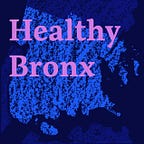Transforming the Cross Bronx: “Capping” the Cross Bronx Expressway Explained
Over the last few weeks, you might have heard buzz about an exciting proposal that impacts our borough: “Capping” the Cross Bronx Expressway, or covering parts of the highway with park space. Local advocacy efforts for this project have been underway for years, led by Nilka Martell of #LovingtheBronx, but have recently started gaining new momentum. This post will catch you up to speed on what “capping the Cross Bronx” means, the recent surge of interest in this project, and how you can learn more and get involved.
What is “capping” the Cross Bronx Expressway?
Before we talk about capping and how it would work, you need to know a little about the Cross Bronx Expressway and its history. It’s a 6.5-mile long highway that traverses the Bronx from east to west, carrying over 175,000 vehicles every day. Constructed in the mid-1900s, the Cross Bronx’s architect, Robert Moses, used federal dollars to design the most expensive one-mile stretch of highway ever built at the time. He refused to solicit input from the Bronx community, and the result was a 6-lane highway bound for Connecticut and Long Island that displaced and divided low-income neighborhoods and communities of color. Today, the neighborhoods surrounding the Cross Bronx Expressway continue to breathe heavily polluted air and experience disproportionate rates of health problems that are linked to pollution like asthma, heart disease, diabetes, and severe COVID-19.
“Capping” the Cross Bronx is one way to begin rectifying this legacy of environmental racism and injustice. The project would involve tunneling portions of the exposed highway and installing air filters so cars and trucks could pass through without adding noise and pollution to the surrounding neighborhoods. Deck parks would then be built on top of the covered highway, which could be used for anything the community wanted — recreation, sports, housing, gardens, farmers markets, you name it. There are a few different versions of this proposal, ranging from capping the whole highway to capping just small sections of it. Experts say it’s most feasible and relatively inexpensive to start by capping the 2.5 miles of exposed highway that run below street level. Other cities like Boston have undertaken similar projects.
Where are #CaptheCrossBronx advocacy efforts now?
Nilka Martell began advocating years ago to cap a small portion of the Cross Bronx Expressway that runs through her Parkchester neighborhood (see photo above). Her work was bolstered by a 2018 report led by Dr. Peter Muennig of Columbia University which examined the cost-effectiveness of capping the Cross Bronx. Dr. Muennig and his team found that the project would pay for itself in reduced healthcare costs and increased property values.
In recent months, the idea has started to gain traction with policymakers at the city, state and federal levels — spurred in part by President Biden’s new infrastructure bill, which presents a funding opportunity, and growing public awareness of racial inequities. Last month, Congressmember Ritchie Torres (NY-15) and Bronx Assemblymember Karines Reyes hosted a press conference calling to cap the Cross Bronx Expressway. Assemblymember Reyes also met with Senate Majority Leader Chuck Schumer to advocate for securing federal funding from the American Jobs Plan, and launched a petition that calls on President Biden and Secretary of Transportation Pete Buttigieg to explicitly fund this project in their infrastructure bill. Many local politicians have signed on, including Congressmember Jamaal Bowman (NY-16).
I’m sold! How can I learn more and get involved?
- Start by adding your name to Assemblymember Karines Reyes’ petition calling on President Biden and Secretary Buttigieg to fund the capping of the Cross Bronx. Sign on here.
- Contact your Congressmember and ask them to support capping the Cross Bronx. Let them know why it’s important to you! You can write them an email, call their office, or tag them on social media. Find out who your Congressmember is here.
- Plug into the advocacy efforts on social media by following LovingTheBronx, The Healthy Bronx, and #CaptheCrossBronx.
- Stay tuned for our next post with a #CaptheCrossBronx reading list so you can continue learning more!
